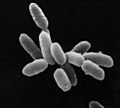 | Haloarchaea (halophilic archaea, halophilic archaebacteria, halobacteria) are a class of prokaryotic organisms under the archaeal phylum Euryarchaeota... 29 KB (2,964 words) - 04:39, 8 April 2024 |
 | exist today are photosynthetic microbes collectively called Haloarchaea. Many Haloarchaea contain the retinal derivative protein bacteriorhodopsin in... 9 KB (1,052 words) - 14:37, 22 April 2024 |
 | Bacteriorhodopsin (Bop) is a protein used by Archaea, most notably by haloarchaea, a class of the Euryarchaeota. It acts as a proton pump; that is, it... 21 KB (2,122 words) - 08:09, 8 March 2024 |
 | 2010. Retrieved 20 July 2009. Dyall-Smith, Mike, HALOARCHAEA, University of Melbourne. See also Haloarchaea. Olsson, Karen; Keis, Stefanie; Morgan, Hugh W... 73 KB (7,720 words) - 14:19, 4 March 2024 |
just osmoprotectants. Of particular note are the extreme halophiles or haloarchaea (often known as halobacteria), a group of archaea, which require at least... 22 KB (2,705 words) - 10:21, 13 March 2024 |
 | contain high concentrations of halophilic microorganisms, primarily haloarchaea but also other halophiles including algae and bacteria. Salterns usually... 5 KB (476 words) - 22:50, 28 March 2024 |
 | had turned pink due to a large presence of the salt-loving "haloarchaea" microbes. Haloarchaea or halophilic archaea is a bacteria culture that produces... 61 KB (594 words) - 09:37, 11 April 2024 |
use a mix of SD sequence, Kozak sequence, and leaderless initiation. Haloarchaea are known to have a variant of the Kozak consensus sequence in their... 30 KB (3,627 words) - 20:06, 12 January 2024 |
within the haloarchaea. Production of these archaeal proteinaceous antimicrobials is a nearly universal feature of the rod-shaped haloarchaea. The prevalence... 7 KB (860 words) - 17:06, 24 February 2023 |
 | species of algae which releases beta-carotene, and the bacteria-like haloarchaea, which together give the water an unusual reddish or purplish color.... 75 KB (8,227 words) - 02:18, 21 April 2024 |
optimum growth occurring Euryarchaeota – In the taxonomy of microorganisms Haloarchaea Halobacteriales – in taxonomy, the Halobacteriales are an order of the... 11 KB (767 words) - 10:32, 20 February 2024 |
 | DasSarma, Shiladitya (2012-01-01). "The core and unique proteins of haloarchaea". BMC Genomics. 13: 39. doi:10.1186/1471-2164-13-39. ISSN 1471-2164.... 14 KB (1,429 words) - 15:59, 17 December 2023 |
Bacteriorhodopsin is a light-driven proton pump used by Archaea, most notably in Haloarchaea. Light is absorbed by a retinal pigment covalently linked to the protein... 13 KB (1,530 words) - 01:29, 14 January 2024 |
hypersaline habitats, which they share with the extremely halophilic haloarchaea. Nanohaloarchaea were first identified from metagenomic data as a class... 12 KB (1,176 words) - 19:02, 2 March 2024 |
Yingchengvirus is a genus of double stranded DNA viruses that infect haloarchaea. The genus was previously named Betasphaerolipovirus. The genus contains... 4 KB (379 words) - 12:34, 30 January 2023 |
hypersaline lake: genomic assessment of ecophysiology among dominant haloarchaea". The ISME Journal. 8 (8). Springer Science and Business Media LLC: 1645–1658... 5 KB (349 words) - 06:27, 12 February 2024 |
 | by the abnormally low Guanine-Cytosine (GC) content compared to other haloarchaea. H. walsbyi has an average of 47.9% GC content compared to the expected... 22 KB (2,535 words) - 11:37, 18 April 2024 |
of the haloarchaeon Haloferax volcanii, and is found in several other haloarchaea. It guides 2'-O-methylation of the wobble residue, C34, of tRNAMet. Joardar... 813 bytes (96 words) - 20:16, 11 November 2021 |
 | Nam, Y. D.; Roh, S. W. (2015). "Occurrence of viable, red-pigmented haloarchaea in the plumage of captive flamingoes". Scientific Reports. 5: 16425.... 44 KB (5,232 words) - 22:37, 14 April 2024 |
 | "Nanohaloarchaeota" Haloarchaea... 18 KB (1,088 words) - 20:26, 21 April 2024 |










